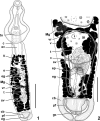Phylogenetic Affinities of Uvulifer Spp. (Digenea: Diplostomidae) in the Americas with Description of Two New Species from Peruvian Amazon
- PMID: 31580785
- PMCID: PMC7584121
- DOI: 10.1645/19-61
Phylogenetic Affinities of Uvulifer Spp. (Digenea: Diplostomidae) in the Americas with Description of Two New Species from Peruvian Amazon
Abstract
Uvulifer Yamaguti, 1934, is a genus of diplostomoidean digeneans that parasitizes kingfishers worldwide. Species have a Neascus-type metacercaria that encysts in or on fish intermediate hosts, often causing black spot disease. Only 3 prior studies published DNA sequence data for Uvulifer species with only 1 including a single named species (Uvulifer spinatus López-Jiménez, Pérez-Ponce de León, & García-Varela, 2018). Herein we describe 2 new species of Uvulifer from the green-and-rufous kingfisher, Chloroceryle inda (Linnaeus), collected in Peru ( Uvulifer batesi n. sp. and Uvulifer pequenae n. sp.). Both new species are readily differentiated from their New World congeners by a combination of morphological characters including distribution of vitelline follicles and prosoma:opisthosoma length ratios. In addition, we used newly generated nuclear 28S rRNA and mitochondrial COI gene sequence data to differentiate among species and examine phylogenetic affinities of Uvulifer. This includes the 2 new species and Uvulifer ambloplitis (Hughes, 1927), as well as Uvulifer elongatus Dubois, 1988 , Uvulifer prosocotyle (Lutz, 1928), and Uvulifer weberi Dubois, 1985 , none of which have been part of prior molecular phylogenetic studies. Our data on Uvulifer revealed 0.1-2.2% interspecific divergence in 28S sequences and 9.3-15.3% in COI sequences. Our 28S phylogeny revealed at least 6 well-supported clades within the genus. In contrast, the branch topology in the COI phylogenetic tree was overall less supported, indicating that although COI sequences are a great tool for species differentiation, they should be used with caution for phylogenetic inference at higher taxonomic levels. Our 28S phylogeny did not reveal any clear patterns of host association between Uvulifer and particular species of kingfishers; however, it identified 2 well-supported clades uniting Uvulifer species from distant geographical locations and more than 1 biogeographic realm, indicating at least 2 independent dispersal events in the evolutionary history of the New World Uvulifer. Our results clearly demonstrate that the diversity of Uvulifer in the New World has been underestimated.
Keywords: Diplostomidae; Uvulifer batesi n. sp .; Uvulifer pequenae n. sp .; Amazon; Brazil; Chloroceryle inda; Kingfishers; Molecular Phylogeny; Peru; Uvulifer ambloplitis.
Figures




Similar articles
-
The Systematics of the Trematoda.Adv Exp Med Biol. 2024;1454:47-72. doi: 10.1007/978-3-031-60121-7_2. Adv Exp Med Biol. 2024. PMID: 39008263 Review.
-
Molecular data reveal high diversity of Uvulifer (Trematoda: Diplostomidae) in Middle America, with the description of a new species.J Helminthol. 2018 Nov;92(6):725-739. doi: 10.1017/S0022149X17000888. Epub 2017 Oct 11. J Helminthol. 2018. PMID: 29017625
-
A New Species of Creptotrematina (Trematoda: Allocreadiidae) from the Red Minor Tetra, Hyphessobrycon eques (Steindachner, 1882) (Characidae) from Brazil, with Comments on the Genetic Divergence of C. Aguirrepequenoi Jiménez-Guzmán, 1973 across a Wide Geographical Range in Middle America.Acta Parasitol. 2024 Dec;69(4):1768-1784. doi: 10.1007/s11686-024-00877-0. Epub 2024 Aug 27. Acta Parasitol. 2024. PMID: 39190278
-
Phylogenetic Relationships of Cardiocephaloides spp. (Digenea, Diplostomoidea) and the Genetic Characterization of Cardiocephaloides physalis from Magellanic Penguin, Spheniscus magellanicus, in Chile.Acta Parasitol. 2020 Jun;65(2):525-534. doi: 10.2478/s11686-019-00162-5. Epub 2020 Jan 9. Acta Parasitol. 2020. PMID: 31919798
-
Challenges in the recognition of trematode species: Consideration of hypotheses in an inexact science.J Helminthol. 2025 Apr 22;99:e54. doi: 10.1017/S0022149X25000367. J Helminthol. 2025. PMID: 40260497 Review.
Cited by
-
A NEW GENUS OF DIPLOSTOMIDS (DIGENEA: DIPLOSTOMOIDEA) FROM THE NILE CROCODILE IN SOUTH AFRICA WITH A KEY TO DIPLOSTOMID GENERA.J Parasitol. 2022 Sep 1;108(5):453-466. doi: 10.1645/22-23. J Parasitol. 2022. PMID: 36223170 Free PMC article.
-
Phylogeny and systematics of the Proterodiplostomidae Dubois, 1936 (Digenea: Diplostomoidea) reflect the complex evolutionary history of the ancient digenean group.Syst Parasitol. 2020 Oct;97(5):409-439. doi: 10.1007/s11230-020-09928-2. Epub 2020 Aug 19. Syst Parasitol. 2020. PMID: 32813221 Free PMC article.
-
Molecular phylogenetic analysis of Neodiplostomum and Fibricola (Digenea, Diplostomidae) does not support host-based systematics.Parasitology. 2022 Apr;149(4):542-554. doi: 10.1017/S003118202100216X. Epub 2022 Jan 19. Parasitology. 2022. PMID: 35042575 Free PMC article.
-
The Systematics of the Trematoda.Adv Exp Med Biol. 2024;1454:47-72. doi: 10.1007/978-3-031-60121-7_2. Adv Exp Med Biol. 2024. PMID: 39008263 Review.
-
Unravelling the diversity of the Crassiphialinae (Digenea: Diplostomidae) with molecular phylogeny and descriptions of five new species.Curr Res Parasitol Vector Borne Dis. 2021 Sep 25;1:100051. doi: 10.1016/j.crpvbd.2021.100051. eCollection 2021. Curr Res Parasitol Vector Borne Dis. 2021. PMID: 35284861 Free PMC article.
References
-
- Blasco-Costa I, Locke S. A. Life history, systematics and evolution of the Diplostomoidea Poirier, 1886: Progress, promises and challenges emerging from molecular studies. Advances in Parasitology. 2017;98:167–225. - PubMed
-
- Boyd E. M, Fry A. E. Metazoan parasites of the eastern belted kingfisher, Megaceryle alcyon alcyon. Journal of Parasitology. 1971;57:150–156.
-
- Caballero E, Diaz-Ungria C. Intento de un catálogo de los tremátodos digéneos registrados en territorio Venezolano. Memoria de la Sociedad de Ciencias Naturales La Salle. 1958;18:19–36.
-
- Derycke S, Remerie T, Vierstraete A, Backeljau T, Vanfleteren J, Vincx M, Moens T. Mitochondrial DNA variation and cryptic speciation within the free-living marine nematode Pellioditis marina. Marine Ecology Progress Series. 2005;300:91–103.
Publication types
MeSH terms
Substances
Grants and funding
LinkOut - more resources
Full Text Sources
Miscellaneous

